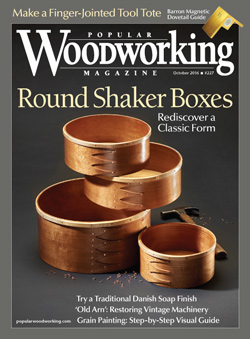We may receive a commission when you use our affiliate links. However, this does not impact our recommendations.
 Woodworking magazines might be dying (or just shrinking), but they aren’t going down without a fight.
Woodworking magazines might be dying (or just shrinking), but they aren’t going down without a fight.
I’ve been reading woodworking magazines since 1992 or so, and I have kept up with all the major titles since at least 1996. I know most of the writers and editors, and I think a lot about their content and how it’s presented. (I cannot help myself, really, because I’ve been in media my whole life.)
During the last 10 years I’ve watched woodworking magazines shrink in every way. Fewer subscribers. Fewer editors. Fewer pages. Thinner paper. Smaller physical pages (what we call “trim size”). It sucks to see this happen because I know that this means that the magazines are struggling.
But what I’ve also noticed is that the quality of the editorial content has been improving in every woodworking magazine. Why? Because the only people left in the business are A-list cage fighters. You have to be good – really good – to keep a print magazine alive in a digital world where a woodworker in tight shorts or a muscle shirt on YouTube can command as many eyeballs as a magazine issue that represents months of work.
When I started in magazines in the 1990s there were no online videos. So the best way to reach woodworkers was to advertise in a woodworking magazine. So a publisher could be somewhat lazy and still run a profitable magazine. As a result, there were too many woodworking magazines that were filled with too much fluff (build a moose with a pencil sharpener in its butt!).
There were also other factors that artificially inflated the number of subscribers, especially the Publishers’ Clearinghouse Sweepstakes (what we call “agent” business), which could artificially inflate subscription numbers to attract advertising that the magazines didn’t really deserve.
All that came crashing down in the 2000s when the agent business evaporated, digital content became dominant and printing and mailing things became (as always) more expensive than it was the year before. Woodworking magazines began to close. Woodwork, American Woodworker and Shop Notes were just a few of the major casualties.
The survivors started acting more realistically. They let their subscription numbers fall to sustainable levels, they cut staff and editorial costs. And they focused on providing content that kicks the butts of the muscle shirts and tight shorts.
Pick up any woodworking magazine, not necessarily Popular Woodworking Magazine, and I think you’ll find fewer dufus-y projects (a “taco corral!”) and more stuff that is thoughtful and simply cannot be found on YouTube. I now look forward to receiving the magazines I’ve subscribed to, instead of dreading the act of sifting through the sludge to find some nugget of goodness.
So don’t give up on magazines yet. I haven’t.
— Christopher Schwarz
Here are some supplies and tools we find essential in our everyday work around the shop. We may receive a commission from sales referred by our links; however, we have carefully selected these products for their usefulness and quality.









I’ve been reading woodworking magazines since the mid-70’s–earlier, if my grandfather’s Popular Mechanix counts. And I’m pretty familiar with the YouTube woodworking community. It’s hard not to know who wears tight shorts, and who always wears muscle shirts. I’ve heard speculation about how much of her following subscribed for tight shorts, but ultimately it’s content that matters. I’ve found hers generally interesting, and his consistently above average. But the criterion for comparison is hazy: “These guys worked for months to put out this magazine, while those guys wear tight shorts and muscle shirts.” It’s ironic to have to pull out a platitude about a book cover in a discussion of content, magazine versus internet.
I’ve let the British magazine ‘Furniture and Cabinetmaking ‘ lapse after subscribing since 1997. Maybe I’m getting old but when virtually all the articles are written by the editor, the letters page and contributions from seasoned writers are dropped and the magazine turns into a review of unaffordable tools its time to go.Sad really but Fine Woodworking still gets my subscription.
Do you have a cutting list or plans for that pencil sharpener?
I have always been willing to try magazines out in my waiting room, but the ones which get renewed are the ones that explore techniques I can use, with less focus on cutesy projects I am unlikely to make. It is the main reason why I check this site almost daily (I usually skip weekends, just because I know that you do…). It is also why I buy many of Chris’s books. I don’t mind paying for what is worth reading, and it doesn’t seem that a woodworking techniques approach can ever run out of things to cover, without having to spend half an issue on a cutesy project.
Like Rick H, I too would be interested to know which magazines you subscribe to. I have been getting PWM and FW for several years and will continue to subscibe to them. I would like to add one or two more to satisfy my woodworking appetite. Two are simply not enough! I have tried a few but were not happy with them and could use some recomendations so I don’t waste my time and money. I love magazines and prefer to have the hard copy in my hands over the digital. I even subscribe to a few other non-woodworking magazines to fill the gap until the next issue comes in the mail. It will be a sad day for me when the printed magazine goes the way of the dinosaur.
Thanks
I let my subscription to PWM expire right before the October issue. I have been getting the magazine off and on for years, along with others. I had been getting American Woodworker for awhile and really liked that magazine. While I like PWM’s content, I don’t like the seven issues a year and the poor paper and smaller size. I like the way Fine Woodworking magazine is laid out, size, paper and picture clarity, and although I have never subscribed to that magazine, I watch for and purchase the magazine when they contain features I would like to read about. I may subscribe to PWM for one more two year period but that is probably going to be it for me. I think I will also subscribe to FWM magazine for two years and decide at the end of that period which one to keep, but FWM has the edge with it’s size, paper and picture clarity. I hope I didn’t hurt anyone’s feelings, I am not saying PWM is a bad magazine or that the editors and content are poor. It’s just undersized in my opinion. Charge more maybe?? I would pay more for eight or nine issues and larger size and better paper quality. One thing I would suggest is, take a readers opinion poll. Ask readers what they would like to see for improvements in the magazine and would they pay more. Post the poll on this forum too. I don’t recall ever seeing that.
I’m a combination of old and new school. I love paper magazines and will always prefer them to online content, but sometimes there is nothing like a how-to video. I’m not sure whether consolidation has made woodworking magazines better. A lot of the paper content seems to be just recycled from the past.
The future will probably continue to be a combination of print and online content until the next big technology comes along. Finding the right combination of online/print content to attract readers and advertisers is the secret sauce that will separate the winners and losers. For the record, I have subscribed to FW for the past 25 years. I also usually have 1-2 other annual woodworking mag subscriptions at any time, depending on what looks interesting.
I tried Kindle subscriptions for magazines for a while. I had switched to that format for casual fiction to save on clutter, and I thought the same idea would apply to woodworking magazines. A few issues in, I realized it wasn’t enjoyable. Woodworking is a visceral occupation, and looking at pixels of them didn’t give me the anywhere near the satisfaction of holding a magazine in my hands. I still watch videos and search for ideas on line, but I really look forward to my magazines and absorbing the ideas (and hard work) of all the contributors.
While I do like my digital stuff I’ll never give up my print magazines. There’s still something exciting about going through the pages of the magazine. I’ve built projects that have been in the magazines. The digital editions are easy to take wherever I am and it’s all on one device but the print magazines will always be my first choice.
I am new to woodoworking and a new subscriber to a couple woodworking magazines and I have been a big fan. I agree that they are, in the main, great. I always look forward to a new issue, and after reading it I invariably have learned something, am inspired, or both.
“….where a woodworker in tight shorts or a muscle shirt on YouTube can command as many eyeballs as a magazine issue”.
Had to chuckle; this is true. Also, notice that almost all of these internet woodworkers are fairly young. Takes some chutzpah IMO, as wisdom and mastery in a craft is typically gained through long years of experience.
Suppose I shouldn’t ask what other magazines you subscribe on the PW site. I’m subscribe to PW and Fine Woodworking right now. Just realized I’ve subscribed to FW off and on since around 1980.
As my own expertise in woodworking has risen, so has my discernment. I pared my subs down years ago and am happy to say the Pop Wood survived the purge. One of the reasons I dumped most of the others was due to superfluity. I mean, how many sawing-carpenter-man whirligigs does the world need? What I needed, and still do, is substance to the article. It’s okay if it’s ANOTHER way to make dovetails, I’m in! Yep, it may be a rehash with new photography, that’s okay because it’s still on-point for refining a skill set.
Truth told, I’m a magazine lover. Dig digital too but I always go for both in my subs. Besides, magazines are something you can share with others. Something analog that you can enjoy with only a little light and some time.
As we know, in an effort to subsidise declining revenues from sales of new content, magazines have started making their back catalogue available online. This is great for the reader but is making the most recent edition worth comparatively less.
To take the magazine cover featured at the top of this post as an example: bent wood (they existed long before the Shakers!) boxes have been featured in the Pop Wood before. I also have digital articles by the competition from ’82, ’93 and 2015. This new article attempts to differentiate itself by a slight change in shape. Reinventing old content used to work when the medium was ephemeral as paper.
This has been taken even further by compilation books such as Flexner on Finishing and your own (excellent) Woodworker series.
For readers like me, who are interested only in a couple of articles in each magazine (I don’t have the space or money for large stationery power tooks so those articles are all wasted) themed compilations are the way forward.
It will be interesting to see how all of this changes over the next few years but the trends suggest three things: Increased specialisation (see M&T magazine), a move away from publishing companies owning offices and workshops to small satellites and home-working and more independent, sponsored production (see The Wood Whisperer).
All of this is good for the consumer and we shouldn’t mourn magazines. The best bits of them, the excellent content producers, will remain.
Vive la revolution.
tight shorts? where? 🙂